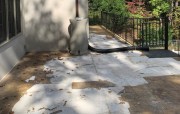The headaches of compliance
Cost. Lead-safe work practices include using tools with HEPA-filtered vacuums, closing off all potential escape routes for dust, and carefully cleaning the entire area at the end of the job. Even workers’ clothing must be cleaned so that they don’t take lead-tainted dust home with them. EPA estimates that the cost of all this ranges from $8 to $376 per job, depending on the scope of work and whether you’ve already been using some of the required work practices. Critics say this cost range is grossly under-estimated.
Inaccurate test kits. Remodeling magazine, a sister publication of Concrete Surfaces, recently reported that EPA has no plans to push for the creation of more accurate lead-paint test kits, even though what is currently available is prone to dramatic errors—incorrectly indicating the presence of lead 22.5% to 84% of the time. Such false positives force contractors to spend thousands of dollars on additional lab tests or else invest substantial resources and money to abide by the provisions of the rule.
In a July 31 letter to the National Association of Home Builders, the agency acknowledged that it is unaware of any test kits on the market or being developed that could produce better results.
What’s ahead
For the past two years, Congress has introduced legislation to lighten the burdens imposed by the RRP Rule. The current bill seeks to reinstate an “opt-out” provision to allow an owner to state that no young children or pregnant women will be exposed to the dust. That opt-out was originally in the measure until the final rule was issued. The bill also would provide an exemption for emergency renovations, allow contractors to correct paperwork errors without facing full penalties, and eliminate the requirement for “hands-on” recertification training so contractors would no longer have to travel to training facilities out of their region.
The House bill (H.R. 2093) was referred to the Energy and Commerce Committee in May, where the bill’s principal sponsor, Rep. Tim Murphy (R-Pa.), heads the Oversight and Investigations subcommittee. It’s identical to legislation introduced in the last Congress and is the companion to S. 484, introduced in the Senate in March. Chances are, if it doesn’t get passed, we’ll see it again next year.
Curbing worker exposure to silica dust
- If you can see dust in the air, then the level is too high to be breathing it. Although respirable dust is too small to see, it is nearly always accompanied by larger visible dust.
- The three ways to keep your workers safe from airborne crystalline silica dust are to prevent the dust from becoming airborne (dust suppression), keep workers away from dusty areas, or use respirators.
- The best, and OSHA-preferred method, is to prevent the dust from getting into the air in the first place. This means vacuum systems or wet-cutting or grinding methods.
- The next best approach is a respirator.
- Paper dust masks cannot filter out respirable crystalline silica dust. Even good respirators can be ineffective with workers who have beards or mustaches. Half- or full-mask respirators with replaceable N-95 filters are the minimum protection required and you should test to assure good fit.
- Controlling dust at the source, especially on interior projects, is the best approach.
Links
Get the EPA’s RRP Rule compliance guide for contractors and read it carefully prior to disturbing any painted surfaces in older buildings.
For more information on the proposed silica dust control rulemaking, visit here.
To read Bill Palmer’s blog post “Safety and Silica and OSHA”, and add your thoughts, visit here.
“Current State of the RRP Rule; An EPA performance Report Card”
Remodeling industry consultant Shawn McCadden gives the EPA a failing grade when it comes to enforcing the Lead: Renovation, Repair and Painting Rule and making children safer.



